A TOTAL ZABRISKIE POINT OF VIEW
Date : 7-12 décembre 1969
Lieu : Technicolor Sound Services, Rome, Italie
Label : 370 ROMAN YARDS
Support : 2 cd
Durée : 157:28 mn
Source : Studio
Qualité sonore : 10/10
Liste des titres :
CD1 – 79:11
01. Heart Beat, Pig Meat (3:10)
02. Country Song (4:39)
03. Fingal’s Cave (1:53)
04. Crumbling Land (5:54)
05. Alan’s Blues (5:44)
06. Oenone (6:50)
07. Rain in the Country (6:52)
08. Come in Number 51, Your Time Is Up (5:02)
09. The Violent Sequence (6:23)
10. Take Off (version II) (1:10)
11. Country Song Theme (band) (2:12)
12. Country Song Theme (acoustic) (1:18)
13. Love Scene 1 (organ and guitar) (6:36)
14. Love Scene 3 (band) (7:51)
15. Love Scene 4 (piano and vibes) (6:54)
16. Love Scene 5 (double vibes) (6:43)
CD2 – 76:47
01. Country Song (full mix) (5:56)
02. The Violent Sequence (Us and Them demo) (5:39)
03. Take Off II and Crumbling Land (film version) (1:50)
04. Crumbling Land (full mix) (5:13)
05. Love Scene 6 (The Blues) (7:26)
06. Love Scene 6 (The Blues – full mix) (7:27)
07. Love Scene 2 (Oenone – full mix) (6:56)
08. Love Scene 4 (piano only) (6:45)
09. Rain in the Country (Unknown Song – alternate version) (6:00)
10. Rain in the Country (Unknown Song – full mix) (6:59)
11. The Christmas Song (2:05)
12. Crumbling Land (edited original soundtrack version) (4:13)
13. Heart Beat, Pig Meat (film version) (2:48)
14. Crumbling Land (film version) (0:44)
15. Come In Number 51, Your Time Is Up (film version) (5:06)
16. Come In Number 51, Your Time Is Up (movie trailer version) (1:40)
Commentaire et sources : This is The Complete Collection of all the known material recorded by Pink Floyd during the Sessions for the Zabriskie Point Soundtrack now released by MQR.
« This Complete Collection is the natural product of years and years of passionate research applied to the Zabriskie Point topic. Over the years many theories have been presented, and we all know a good researcher has to prove his theories whenever possible.
In recent years my dedication has yielded the deserved prizes.
I had the luck to get from Glenn Povey what I call simply The Document, part of the ZP recording sheets of EMI studios. I was also able to make contact with Don Hall, the Music Adviser of the movie. I’m honored to say that this contact became a real friendship. With my great satisfaction almost all my theories, even the most incredible, were confirmed.
WRomanus »
What we at MQR present here is a modular opera set in three stages.
The core of all this are clearly the eight songs of The Lost Album – 370 Roman Yards, the great find of all the research, which is the closest thing possible to the album that would have been released by MGM-Pink Floyd in 1970 if they had been sole musicians on the soundtrack of the film. The Lost Album was extended with the eight Main Outtakes, a-la Rhino Rekords release, forming the CD One of the Collection.
The CD Two is mainly made by all the Other Outtakes and the Film Versions.
The order of the songs of the different blocks follow about the order of the movie scored totally with music by Pink Floyd.
The mixes on this Collection are either the mixes made by Pink Floyd for release, or as close as we could make using the material available. We have restored and enhanced everything using the best technology and skills available to us. The quality of these tracks varies due to the sources used, but we have done our best to make it all sound as good as possible.
The History
In the summer of 1969 Michelangelo Antonioni completed the filming of his visionary and prophetic view of America and our society. All that was left was to complete the movie with a good soundtrack. Antonioni was interested in everything that was new and trendy among young people. Don Hall was on the air during his nocturnal DJ program on KPPC FM Pasadena when he was contacted personally by Antonioni at the end of the summer of 1969. Antonioni really liked Don and invited him to have some screenings of the movie. After that Don provided a list of songs he felt would work, most coming from his program. Antonioni asked MGM to hire Don as Music Advisor for the soundtrack and came back to Roma (Don still has a letter from Antonioni, sent from Rome with the list of the songs he’d like to be in the movie, all songs for the radio-desert sequences).
Still they had to find how to score all the main sequences: Beginning, Violent, Take Off, Love and Explosions (and eventually more). Antonioni wanted original music for those sequences. Many artists and bands were contacted to write original music for the movie, but none of them was asked to write the whole soundtrack of the movie.
In October ’69 Don was in Rome with Antonioni trying to find a way to score the whole movie in time for Christmas. Near the end of the month it happened that Clare Peploe (co-writer of the movie and Antonioni’s girlfriend at the time) brought to Rome a brand new copy of the new Pink Floyd album, Ummagumma, from London. Antonioni, Don Hall and Clare listened to the new album with a small stereo at Antonioni’s house in Rome. Antonioni REALLY liked Ummagumma and listened several times to the whole album. He liked “Careful With That Axe, Eugene” very much and told Don that he’d like a new version for the final sequence of Zabriskie Point. They decided to try and hire Pink Floyd to record all the original music they needed for the movie. MGM contacted Pink Floyd. After that Steve O’Rourke came to Rome alone during the first days of November ’69 to check and organize it all. All was done in few days, and Pink Floyd came on the 15th of November with Pete Watts and Alan Stiles, cancelling some shows planned for their present tour. Antonioni and Don showed the movie to them several times with some scenes already scored, highlighting those without. At that point Steve and Roger Waters had a talk and asked Antonioni to try to score the whole movie. He, been enthusiastic about Ummagumma, agreed.
Pink Floyd produced a large quantity of music, especially for the Love Scene but Antonioni was not satisfied and the sessions ran longer than planned. In the end Pink Floyd went back to London with some songs to finish. Out of all the entire production of songs, including themes and variations, Antonioni ended up using only three songs. He kept on searching for « something better » till the last days before the premiere of the movie. In London Pink Floyd completed their final versions of eight songs with the intent of them being their eventual album for the Zabriskie Point soundtrack.
THE SOURCES
Some songs used here were released officially, originally by MGM in 1970 and then in the extended edition by Rhino Records in 1997. Other songs come from two celebrated unofficial sources, the bootlegs Omayyad and A Journey Though Time and Space. Thanks to grolsch, recently a better transfer of the ZP outtakes portion was made from the master tape used for Omayyad just for this work. Mostly of the outtakes come from A Journey Though Time and Space. The Film versions are based on the DVD releases of the movie. The Christmas Song was aired by John Peel in 1975. The edited Violent Sequence is from the Dark Side Immersion Set.
CD1: 01-02-04*-05*-08 and CD2: 05-08-09-12-15-16 from Zabriskie Point – Extended Soundtrack 2CDs
CD2: 13 from Zabriskie Point DVD.
CD1: 03-04*-06-07 from a Tape copy of the mastertape used to make the Omayyad bootleg LP
CD1: 05*-09-10-11-12-13-14-15-16 and CD2: 01-03-04-06-07-10-14: A Journey Through Time & Space bootleg CD1
CD2: 02 from The Dark Side Immersion Set released in September 2011.
CD2: 11 from an Unknown gen. tape with the John Peel’s broadcast.
TITLES & SONGS
The name of the Collection is self-explanatory; A Total view on the Zabriskie Point Sessions.
If the Lost Album had really been released in 1970 it wouldn’t have a title any different than Soundtrack For The Film Zabriskie Point. A title is needed today to highlight this one from the multitude of collections released in the intervening years.
This title is invented based on Roman Session and assonance with the title of Omayyad. All the songs’ titles are real, although “Country Song” and “Alan’s Blues” were only working titles. We knew all the working titles with the find of The Document where all are listed. The three new titles, “Fingal’s Cave”, “Oenone” and “Rain in the Country”, are taken from Omayyad, and for so many years were considered the fantasy titles of bootleggers. Last year Don Hall confirmed that he aired those songs on KPPC FM Pasadena and announced them with just those names, as they were written on the tape’ boxes sent to him by Pink Floyd as their final versions. Omayyad was made from a recording of that broadcasting.
For the numbering of « Love Scene » outtakes we take the MOB’s study on the topic except the big difference about « Oenone ».
Here is it.
From official sources we know Pink Floyd made at least 6 attempts for « Love Scene »
– #4 is the quiet piano piece
– #6 is the blues piece
On AJTT&S, tracks 7-8-9 seem to come from a continuous tape (thereis no tape cut).
Since track 7 is « Love Scene #4 » and track 9 is « Love Scene #6 », it is logical to assume that track 8 is « Love Scene #5 ».
It is also important to note that during the Interstellar Expo in Paris, late 2003, a 8-track master reel of the sessions was exposed.
The label clearly mentions Love Scene #4 as a piano/vibes track, Love Scene #6 as the « blues version », and between them, Love Scene #5, which is indicated as a « vibes version », with 2 different vibes tracks.
This definitely confirms that AJTT&S track 8 must be Love Scene #5.
On AJTT&S again, tracks 10-11-12 could be also from a continuous tape (even if track 11 fades out early). This is why it was assumed that:
– AJTT&S track 10 = « Love Scene #1 »
– AJTT&S track 11 = « Love Scene #2 » (intro only, the complete version is AJTT&S track 4)
– AJTT&S track 12 = « Love Scene #3 »
– Oenone, the final version, is similar to #2
CD ONE
The Lost Album – 370 Roman Yards
1. Heart Beat, Pig Meat
This song is made up of the coming and going of Rick’s Farfisa organ, Dave’s excursions, recordings coming from televisions and talking lines by Don Hall, all over a heart beat like track created by tapping on a microphone. This is the first time Pink Floyd use a heart beat, but certainly not the last. It’s the soundtrack for the opening sequence of the movie with the titles, and one of the three songs ultimately chosen by Antonioni. It was performed live sometime in early 1970 as the initial part of an experimental suite. It’s the official version recorded in Nov. ’69. The working title was Beginning Scene.
2. Country Song
With this song Pink Floyd meant to score some of the scenes in the desert with Daria driving her car as Don Hall confirmed. The song was adapted into several versions in different styles, all recorded with the intent of being used as “Daria’s Driving Theme”. One of the two song for the movie with lyrics, which are in this case inspired by Alice in Wonderland. Sourced from the Rhino release, was recorded the 12th Dec. ’69, it came to us with its working title, probably because it was rejected before the end of the work.
3. Fingal’s Cave
This name referred to Irish Mythology and a place in the Scottish isle of Staffa. This energetic song was written for the first Flying Scene of the movie together with two more songs. It is rare to hear a loud, bombastic blues number like this performed by Pink Floyd, and only a couple pieces on More come even close to it stylistically. It came to us through the bootleg Omayyad. Recorded in Nov. ’69, the working title was “Take Off (version I)”.
4. Crumbling Land
This is the long studio version with all the traffic noises recorded by Nick Mason in the streets of Rome. It came to us with the bootleg Omayyad.
Since the musical part is the same as the official one, a merge was made with the two. The result is a restored complete studio version. Having an unusual rhythm for a Pink Floyd song it’s considered a country song, although in the end it’s not. For the movie only 34 seconds were used, and those were from an early take, not from the final version. The title and some of the lyric content refer to Zabriskie Point (the place), to USA and the lyrics even include a reference to Michelangelo Antonioni. Recorded the 13th Dec. ’69, the working title was “Highway Song”.
5. Alan’s Blues
This song arrived to us with its strange working title, probably because, similar to Country Song, it was rejected before the end of the work. Although we have evidence that in December ’69 it was still intended to score a movie scene. Alan Stiles was a roadie, present in Rome for the sessions.
When this was not released the band paid tribute to him with another number, Alan’s Psychedelic Breakfast. The base for this song was recorded the 16th of Nov. ’69 as an attempt to satisfy Antonioni with a Blues for the Love Scene.
Once rejected for that, it was shortened to fit the roadhouse in the desert scene or perhaps another desert scene. It was mixed from both Rhino release and AJTT&S bootleg. This kind of blues was performed live many times over the next three years.
6. Oenone
The name refers to Greek Mythology, similar to Sisyphus recorded a few weeks before. Oenone was a nymph married to Paris of Troy. He left her for Helen of Sparta. Oenone was an isle as well, connected to the Sisyphus story (!). This song came to us with the bootleg Omayyad. It was recorded in Nov. ’69 for the Love Scene. Love Scene was the working title for it, as on the released tracks on the Rhino soundtrack. Pink Floyd tried four different musical styles to please Antonioni for that scene, including a blues. This is the style that worked the best, from Pink Floyd’s point of view. It comes from several psychedelic approaches they tried under the direction of Antonioni.
Great psychedelic performance by Rick and Dave, using techniques they experimented with live during Set The Controls, A Saucerful of Secrets and The Man & The Journey.
7. Rain in the Country.
Along with “The Narrow Way Part 1”, this song almost certainly has it’s roots in “Baby Blue Shuffle in D Major” and in the second part you can clearly hear the germination of Atom Heart Mother (in fact The Amazing Pudding was performed only one month later…). Probably another of many approaches to the Love Scene, Pink Floyd tried it for Antonioni coupled with the desert scenes as well, as Don Hall confirmed. One of Gilmour’s more interesting early compositions which really showcases his acoustic playing. We aren’t certain of the origins for the title but it was likely designed to create contrast with the dry locations of the movie. This was recorded the 6th Dec. ’69 and the working title remains unknown. In fact a dissimilar mix was called “Unknown Song” on the 1997 Rhino Expanded Soundtrack. The final version is the one of the bootleg Omayyad.
8. Come in Number 51, Your Time Is Up.
The perfect song for the final sequence. This song is the reason Pink Floyd were called to score the important scenes of the movie by Antonioni, who was impressed by Ummagumma. It’s a remake of “Careful with that Axe, Eugene”, but with some variations. There is no whispered sentence before the shout, the shout itself bursts in together with the guitar solo, long and repeated. Dave’s solo is absolutely vigorous and demoniac and the song reaches high levels of intensity. The end comes suddenly without the usual gradual slowing down.
The title refers to the TV series « Q », a surreal comedy show in the vein of (and forerunner to) Monty Python’s Flying Circus, and its creator, comic Steve Milligan, who spoke that line. It’s the official version. Recorded in Nov. ’69, the working title was Explosions, in reference to the scene that it was to be used for.
The Main Outtakes (The Extension of 370 Roman Yards)
9. The Violent Sequence.
This came from Rick Wright in Nov ’69 and was rejected, leaving the scene with no music. It was one of the few ZP songs played live sometime in early 1970. Two years later it evolved into Us and Them. Titled like that by Pink Floyd, it comes from the AJTT&S boot.
10. Take Off (Version II)
The second attempt recorded in Nov. ’69 to satisfy Antonioni for the flight above LA. A 3rd unknown version was also written. It comes from AJTT&S bootleg. Wrongly believed to be a sort of rock intro for a Crumbling Land take.
11 & 12. Country Song Themes
Two variations of Country Song probably recorded in Nov. ’69 used to score some desert scenes.
One is palyed by the band with Dave’ scat. The other is an acoustic couple guitar and harpsichord.
Both coming from the AJTT&S Bootleg.
13 to 16. Love Song Variations
In this disc we have the various attempts at scoring the Love Scene. Pink Floyd clearly preferred the psychedelic angle for this scene like the Love Scene 1 and 3. We have testimony that Antonioni was interested by the effect of vibes and Pink Floyd recorded Love Scene 3 and 4. All written in Nov. ’69 and coming from the AJTT&S bootleg.
CD TWO
The Other Outtakes
1. Country Song (full mix)
A full mix with some tries and a longer guitar solo.
2. The Violent Sequence ((Us & Them demo)
From the Dark Side Immersion Set, it’s the same of CD ONE but edited shorter.
No properly called Us and Them Rick’s demo.
3. Take Off (Version II) and Crumbling Land (film version)
We decided to include this couple as a document, cleaned and restored, since is what was used to cover a couple of sequences. This Crumbling Land is the same used in the movie. Misnamed for years as one song called something like Crumbling Land – Rock Intro.
4. Crumbling Land (full mix)
The « full mix » version comes from AJTT&S and is from the same take as the soundtrack
version with all the tracks in the mix.
5 & 6. Love Scene 6 (The Blues and full mix)
They source from Rhino Release and AJTT&S boot. Once rejected as Love Scene, it was recycled as a desert scene song and called temporarly Alan’s Blues. Recorded the 16 Nov. ’69.
7. Love Scene 2 (full mix – Oenone)
This « full mix » version generated the final version Oenone. Here we can hear even
a sex performance mimed with vocals by Roger and David. It comes from AJTT&S.
8. Love Scene 4 (piano only)
It comes from the Rhino Record release. Antonioni liked and considered this beautiful piece from Rick asking to add vibes.
9 & 10. Rain in the Country (Unknown Song – alternate version and full mix)
The alternate comes from the Rhino Release and the full mix from AJTT&S.
Rain in the Country, the final version, came from the full mix.
A Special Outtake
11. The Christmas Song
We have evidence this was recorded in Roma during a pause. Probably they recorded this after a request by John Peel. Once again Alan Stiles is involved. Nick Mason is singing for the first and unique time of his Pink Foyd career. Nick is calling the song with this title in an interview of 1971.
Official Soundtrack Version
12. Crumbling Land (soundtrack Edited version)
This became only a document once was discovered that MGM edited in this way the real final version by Pink Floyd.
Film Versions
13. Heart Beat, Pig Meat (film version)
It’s the only song of the whole Collection coming from the DVD release of the movie since some different mix are present in this version.
14. Crumbling Land (film version)
Different from the final version of the song, it’s an acoustic mix of the third track of this CD. To restore this piece the AJTT&S source was used.
15. Come In Number 51, Your Time Is Up (film version)
The source for this was actually our restored version from the official Soundtrack, but only the right channel was used. This was exactly the same mix as used in the film. The edit just before the scream was recreated, and the sounds from the film inserted into the break. The song then resumes until the end.
16. Come In Number 51, Your Time Is Up (movie Trailer version)
We liked to restore this short version invented by the filmakers to make the Trailer. We used the official version since the rips of VHS and DVD had a bad quality. We offer it like a bonus here without the dialogue it has on the trailer.
Disponible en format flac* : http://www.guitars101.com/forums/f145/pink-floyd-1969-1970-a-total-zabriskie-point-of-view-stu-flac-125674.html
*Assurez-vous que le téléchargement de ces fichiers ne contrevienne pas à la législation en vigueur.Pochette :
La totalité des scans de pochette (y compris les 24 pages du livret) sont disponibles en haute définition ici : http://floydart.org/artwork/atzpov/
Bootleg n°1601
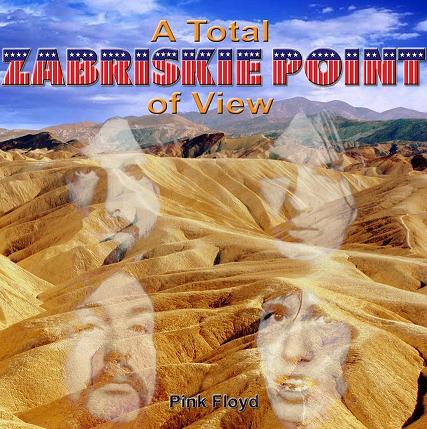

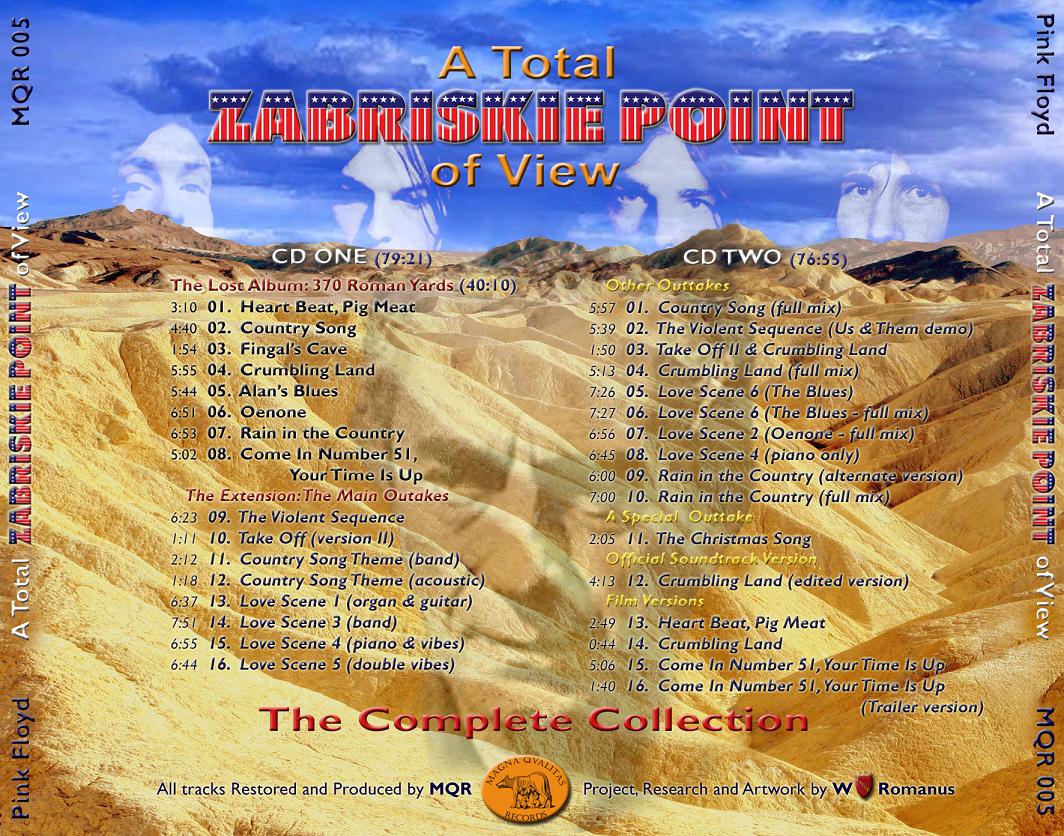
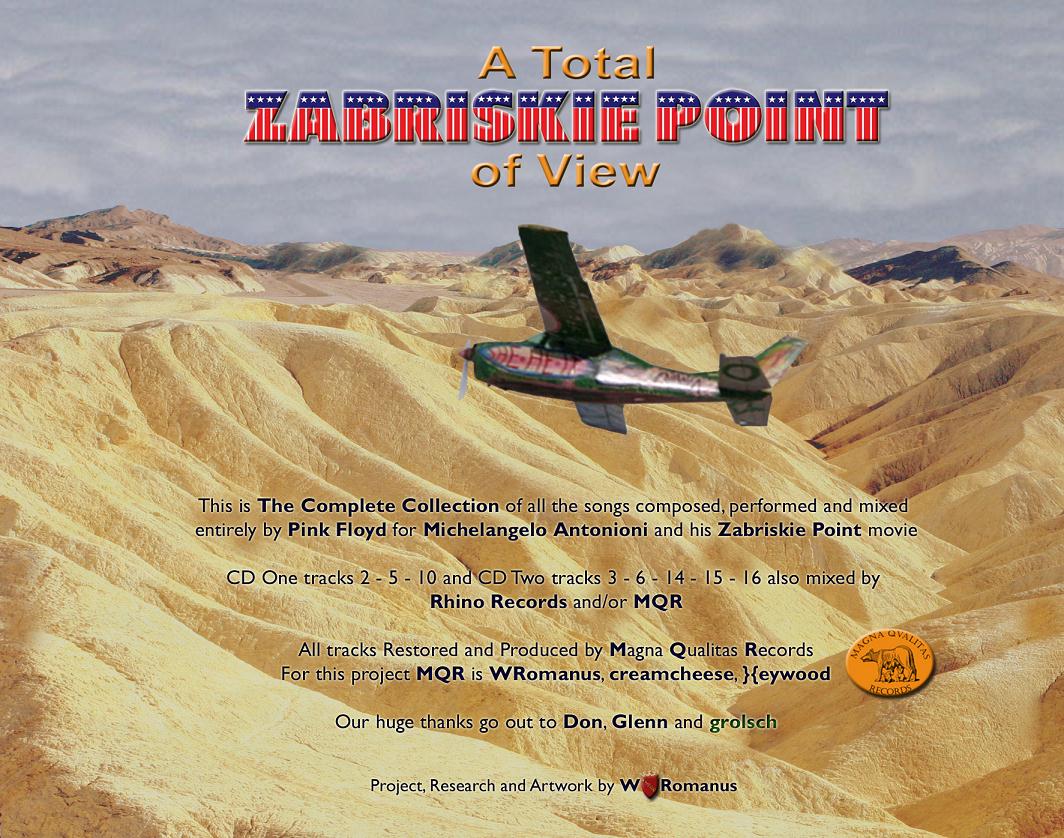
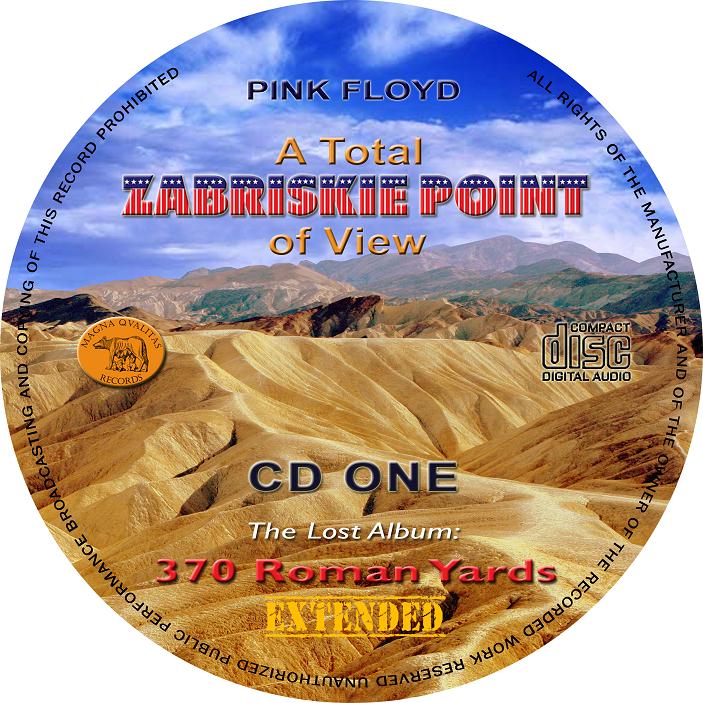
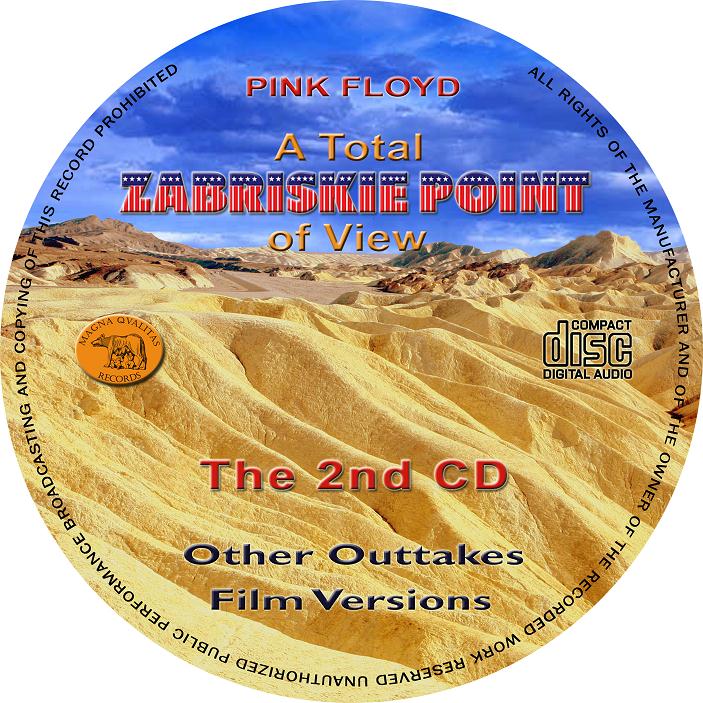
Really nice… sounds superb, like an official (big company) release.